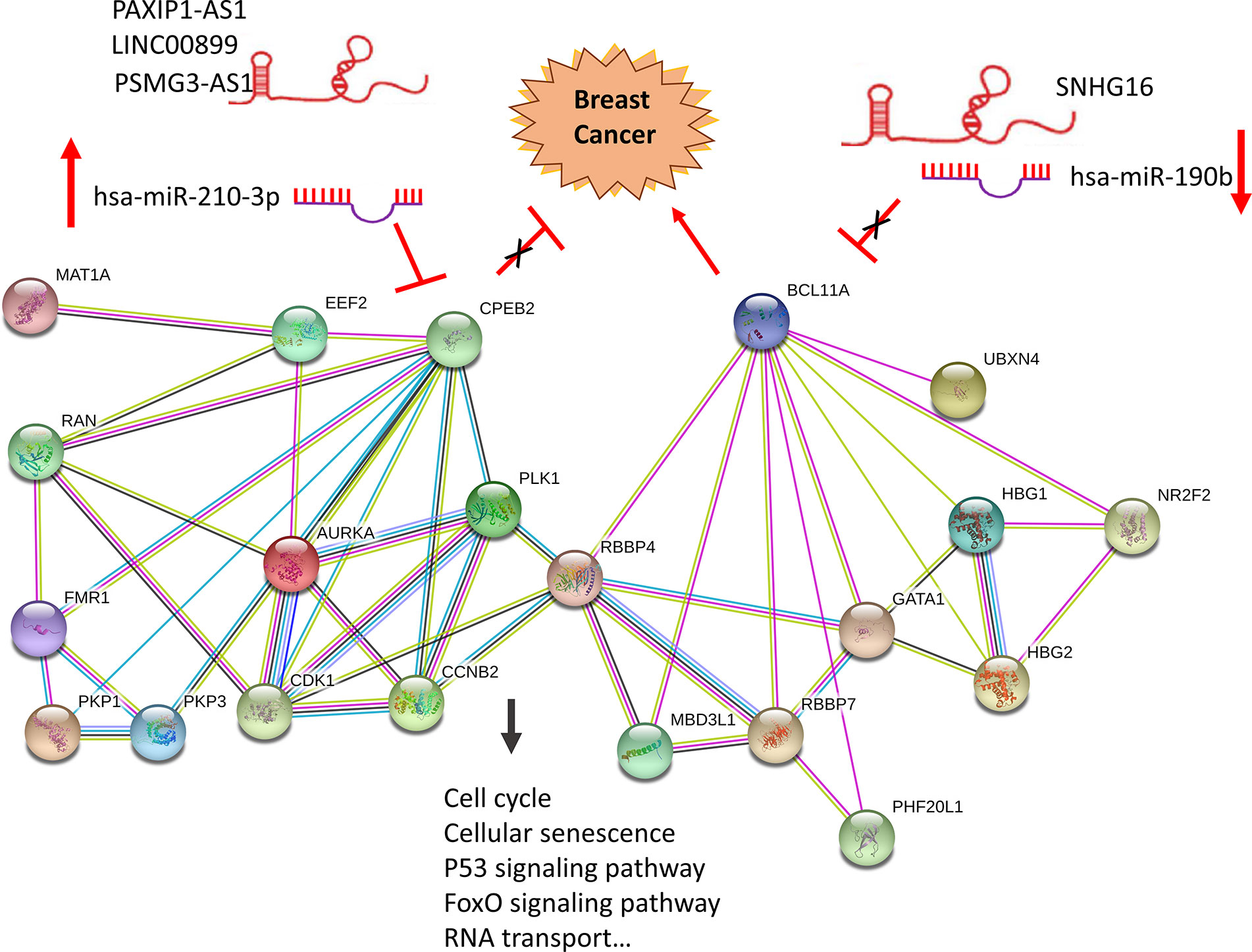Hypoxia-Associated Prognostic Markers and Competing Endogenous RNA Co-Expression Networks in Breast Cancer
- 1Department of Breast and Thyroid Surgery, Zhongnan Hospital, Hubei Key Laboratory of Tumor Biological Behaviors, Hubei Cancer Clinical Study Center, Wuhan University, Wuhan, China
- 2Department of Pathology and Pathophysiology, Hubei Provincial Key Laboratory of Developmentally Originated Disease, School of Basic Medical Sciences, Wuhan University, Wuhan, China
A Corrigendum on
Hypoxia-Associated Prognostic Markers and Competing Endogenous RNA Co-Expression Networks in Breast Cancer
By Gong P-J, Shao Y-C, Huang S-R, Zeng Y-F, Yuan X-N, Xu J-J, Yin W-N, Wei L and Zhang J-W (2020). Front. Oncol. 10:579868. doi: 10.3389/fonc.2020.579868
In the original article, there was a mistake in the legend for Figure 8 as published.
The correct legend appears below.
In the original article, there was a mistake in Figure 8 and Table 4 as published. Due to our carelessness, “hsa-miR-210-3p” and “hsa-miR-190b” were wrongly written as “has-mir-210-3p” and “has-mir-190b”.
The corrected Figure 8 and Table 4 appears below.

Figure 8 Construction of a hypoxia related ceRNA regulation network based on differentially expressed miRNAs and DEGs. Loss of LINC00899, PSMG3-AS1 and PAXIP1-AS1 leads to increased hsa-miR-210-3p. When overexpressed, hsa-miR-210-3p impedes translation of CPEB2, a tumor suppressor gene in breast cancer under hypoxia status. High expressed SNHG16 can suppress hsa-miR-190b, which leads to increased expression of BCL11A, an oncogene in breast cancer.
In the original article, there was an error. “LINC00899/PSMG3-AS1/PAXIP1-AS1- hsa-miR-210-3p-CPEB2 and SNHG16- hsa-miR-190b-BCL11A” were wrongly written as “SNHG16-hsa-miR-210-3p-CPEB2 and LINC00899/PSMG3-AS1/PAXIP-AS1-hsa-miR-190b-BCL11A”.
A correction has been made to the Abstract, under ‘Results’:
“Predictions based on the LINC00899/PSMG3-AS1/PAXIP1-AS1- hsa-miR-210-3p-CPEB2 and SNHG16-hsa-miR-190b-BCL11A ceRNA regulation networks indicated that the two genes might act as tumor suppressor and oncogene, respectively.”
A correction has also been made to Discussion, paragraph 6:
“Further we use data contained in databases such as StarBase, mirDIP, Kaplan-Meier Plotter and TCGA, based on ceRNA theory, we identified potential ncRNA regulatory pathways involving a tumor suppressor and an oncogene, LINC00899/PSMG3-AS1/PAXIP1-AS1- hsa-miR-210-3p-CPEB2 and SNHG16- hsa-miR-190b-BCL11A ceRNA regulation networks, and built a local PPI network which might promote the development of breast cancer under hypoxia.”
In the original article, there was another error. “SNHG16” and “LINC00899, PSMG3-AS1 and PAXIP-AS1” were incorrectly interchanged.
A correction has been made to Results, under ‘A Hypoxia Related Competitive Endogenous RNA (ceRNA) Regulation Network’:
“In this network, loss of LINC00899, PSMG3-AS1 and PAXIP1-AS1 leads to increased hsa-miR-210-3p. When overexpressed, hsa-miR-210-3p impedes translation of CPEB2, a tumor suppressor gene in breast cancer under hypoxia status. High expressed SNHG16 can suppress hsa-miR-190b, which leads to increased expression of BCL11A, an oncogene in breast cancer.”
In the original article, there was a further error. The authors stated that CPEB2 and SNHG16 have been shown to act as tumor suppressor genes in breast cancer.
A correction has been made to Discussion, paragraph 6:
“In addition, CPEB2 has been shown to act as a tumor suppressor gene in breast cancer.”
The authors apologize for these errors and state that they do not change the scientific conclusions of the article in any way.
The original article has been updated.
Keywords: hypoxia, breast cancer, The Cancer Genome Atlas, ceRNA, prognosis
Citation: Gong P-J, Shao Y-C, Huang S-R, Zeng Y-F, Yuan X-N, Xu J-J, Yin W-N, Wei L and Zhang J-W (2021) Corrigendum: Hypoxia-Associated Prognostic Markers and Competing Endogenous RNA Co-Expression Networks in Breast Cancer. Front. Oncol. 10:637481. doi: 10.3389/fonc.2020.637481
Received: 03 December 2020; Accepted: 04 December 2020;
Published: 29 January 2021.
Approved by: Frontiers Editorial Office, Frontiers Media SA, Switzerland
Copyright © 2021 Gong, Shao, Huang, Zeng, Yuan, Xu, Yin, Wei and Zhang. This is an open-access article distributed under the terms of the Creative Commons Attribution License (CC BY). The use, distribution or reproduction in other forums is permitted, provided the original author(s) and the copyright owner(s) are credited and that the original publication in this journal is cited, in accordance with accepted academic practice. No use, distribution or reproduction is permitted which does not comply with these terms.
*Correspondence: Jing-Wei Zhang, zjwzhang68@whu.edu.cn
 Peng-Ju Gong1
Peng-Ju Gong1 Jing-Wei Zhang
Jing-Wei Zhang